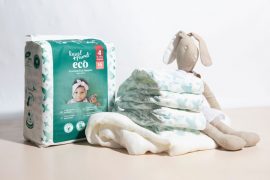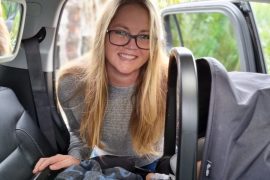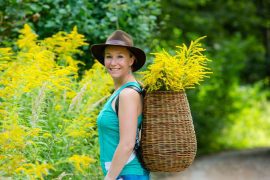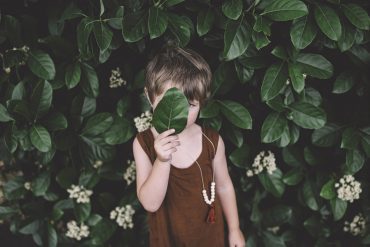2. Teach children about sustainability by showing them what others are doing to help. Also show them what not to do.
It’s important for kids to know that they’re not too young to care; not too young to help.
Have you heard of Greta Thunberg, a 16-year-old girl from Sweden? She’s a climate activist who’s inspired marches for young people around the world. She just completed an incredible 15-day, 3,000-mile (4,800km) voyage on a carbon-neutral boat across the Atlantic to bring awareness to climate change. She will speak at the United Nations Climate Summit this September. Here’s her very compelling speech to the Assemblée Nationale: https://youtu.be/J1yimNdqhqE
Greta’s work is inspiring and wonderful, yet she’s not the only one who’s doing good work for the planet. Young activists are doing important climate work all over the world. Share their stories with your children. Watch your children’s reactions to others’ work to learn which elements of protecting our planet speak to their hearts. Then, foster those things. Do they love marine animals? What about their favourite forest creatures? Do your kids enjoy hiking, playing outside in good weather, or boating with Grandpa? See what other people are doing to make enjoying those things possible for your child. Tie those things into your discussions. They’re specific. They’re memorable.
As with all topics, you’ll be more likely to succeed at teaching your message about sustainability if your child feels emotionally compelled to learn. Just like some kids enjoy math for the sake of numbers and others don’t care about math until they discover physics, pay attention to what resonates with your child. Show them what others are doing in an area that inspires them. Read books together about ways your children can help protect the planet. Check them out from your local library if you can.
Conversely, even with young kids, point it out when you see something that’s contrary to protecting the earth. Be it a cigarette butt on the pavement, smoke spewing from a manufacturing facility, or someone acting irresponsibly towards our planet in any way, it’s perfectly okay to point it out and say, “Yuck.” Explain why it’s off-putting.
What you can say to your child: “I don’t like it when people leave their trash near the lake. It’s dirty and can make the fish and animals here very sick. I want people to do better.” Bonus points: pick up the trash and take it to the nearest bin. Pack an eco-friendly hand sanitiser to keep with you if you’re concerned about cleanliness.
Show children that the generation before them is doing something to protect them. Kids need to know that adults outside your home care about sustainability too – lest they feel as overwhelmed as we do. It’s hard to feel like an activist in isolation. Show them they’re not alone. Find role models they admire (famous or not) and share with them what those people are doing.
Raffi, the beloved children’s troubadour and creator of his namesake Foundation for Child Honouring, wrote two wonderful new songs about the climate emergency (“Young People Marching – for Greta Thunberg” and “Do We Love Enough”). Here’s his press release. You can stream the songs from here.
I’d love to say, “Show kids that we’ve got this.” Although I can’t do that, I’ll write, “Show them that we’re working on it.”
3. Lead children to help our planet by showing them how to be change makers.
In addition to modelling for your kids all the ways you’re protecting our planet, challenge them to find ways to be change makers themselves. See what they come up with. Here are a few examples:
- Help them identify all the “one hit wonders” (items that are typically disposed of after a single use) in your home. What do they see that your family would use only once? What alternatives can they think of to replace those things? They might already know about swapping paper towels and sponges for eco-friendly dish cloths, eliminating dryer sheets, and using glass or stainless steel water bottles instead of plastic. What else can they find? If they find a one-hit wonder but don’t know of a reusable option with which to replace it, might they invent one? Rethink whether one hit wonders are really just for one time only. People often assume they have to use certain items only one time because they “feel” disposable. But are they? Even a homemade birthday sign is reusable (your child can help with a tweak or two).
Be it birthday streamers or decorations, wrapping paper or ribbons, take a single “day in the life” and see what you can reuse again another day. I never realised that I’d inherit my great grandmother’s habit of saying, “Don’t tear the wrapping paper – we’ll use it again next year!” but here I am. (I plan to phase out wrapping paper entirely once what we’ve been reusing no longer holds together.) Encourage your children to challenge their friends to nix single use items in their homes, too. Frame it as an ongoing scavenger hunt. Every day holds opportunities to rethink that which we used to consider disposable. - Avoid buying single use products altogether when you see them in stores. Go farther, though. Ask whoever’s in charge to consider replacing them with sustainable alternatives. If need be, brainstorm with them about what those alternatives might be. Make it easy for them to champion change within their organisations.
- Encourage your children to keep their eyes open for ecological missteps. Just like with the single use products, they can look for products sold in irresponsible packaging. Write to the companies who use plastic unnecessarily or excessively.
You don’t need to sail across the ocean like Greta did. Solar panels and electric cars aren’t feasible for everyone, and we can’t always choose whether our homes are powered by wind turbines. However, until more of those things are commonplace, you can write letters with your children. Make phone calls. Model to your children that communication matters-because their future on this planet matters.
Teach children about how to protect the earth because they have even more at stake than we do. The normal order of things is for them to outlive us on a safe and healthy planet.
Just a few weeks ago, Greenland lost 12.5 billion tons of ice in a single day. Our world needs help quickly. Yet, we can’t force kids to be stewards of the earth; it’s our job as conscious parents to model these things for them. They’ll follow our lead. As a bonus, the more you instil your messages in your kids, the more they’ll hold you accountable too. Your actions will become their actions as they grow up. They’re paying attention now.
Another day is imminent. Another world is possible. –
Raffi Cavoukian
Originally published HERE
Sarah R. Moore is a published writer, positive parenting educator, wellness advocate, and world traveller. Her work spans the globe, reaching readers on six continents and appearing in publications such as The Natural Parent Magazine, Scary Mommy, and Macaroni Kid.
She has been certified by the Raffi Foundation for Child Honouring. She wholeheartedly recommends the course for parents, educators, and all others who influence the lives of children.
She also holds BA/MFS degrees in Journalism, French, and Media/Arts/Cultural Production. Read more about Sarah here.
You can follow Sarah at Dandelion Seeds Positive Parenting on Pinterest | Facebook |Instagram |Twitter.










